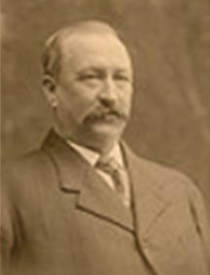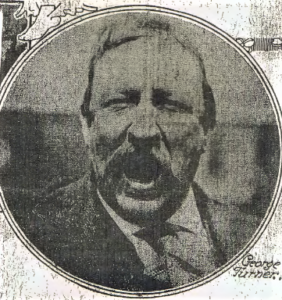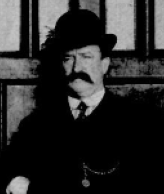Title: Track coach, trainer, instructor, field manager
Birthdate: September 26, 1850
Death Date: January 20, 1908
Plot Location: Section 21, Lot 79, south line

There are certain terms that most every Philadelphian would recognize. One is Franklin Field and another is the Penn Relays. George Turner was there when they were first created.
George grew up with his two brothers and two sisters in a very English-sounding place called Leicestershire, England. When he immigrated to this country in 1873, he met a girl from a very German-sounding place called Vorderbuechelberg in what was then called Prussia. Just as Queen Victoria married her German-speaking soul mate whose name was Albert, George married his, whose name was Henrietta Schaeffer.
Their daughter was born as their new country celebrated its Centennial in the summer of 1876. Seven more offspring were born but only two, the firstborn, Louisa, and the last-born, William, would outlive their parents.
Philadelphia was a major textile center in those days, and George worked as a wool sorter in a mill. By the mid 1880s, however, he found his dream job when he was hired by the Athletic Department of the University of Pennsylvania.
He wore many hats: instructor, trainer, track coach, groundskeeper, and the man who yelled, “on your mark, get set” and then fired the pistol. In fact, newspaper  obituaries focused on his high regard as a “starter” in the Intercollegiate Athletic Association (forerunner to the NCAA) because of his impartial reputation. A newspaper photographer captured him here as he was “setting” a race.
obituaries focused on his high regard as a “starter” in the Intercollegiate Athletic Association (forerunner to the NCAA) because of his impartial reputation. A newspaper photographer captured him here as he was “setting” a race.
To create some added interest to an upcoming meet in April of 1893, the University Track Committee wanted to try something different, a relay race. They weren’t the first to try it, but this was where it took hold and flourished. Four men each ran a quarter mile in succession, which today is called the 4 by 400 meter relay.
After a quiet contest with Princeton was held that year and again in 1894, the “Penn Relays” were announced for 1895 to officially dedicate the new Franklin Field. Both high school and college teams have been competing every spring in that same location ever since.
Franklin Field. Both high school and college teams have been competing every spring in that same location ever since.
What role George played on that committee is unknown, but he supervised the installation and careful maintenance of the new track. He was well known among students whether they were athletes or not, and even agreed to train a group interested in starting a fencing club. For many years he helped coach high school teams, letting them use his track, simply because of his interest in young athletes.
George had to miss the 1907 Penn Relays due to a foot infection. His immune system was weakened by diabetes, which led to gangrene. Doctors at the University of Pennsylvania decided to operate on January 19, 1908 but it was too late. He finished his last race.
 A crowd of students attended the funeral held at his daughter’s house. Fundraising began to place a plaque in his honor in the gymnasium. Henrietta and five children are buried with him here in Section 21.
A crowd of students attended the funeral held at his daughter’s house. Fundraising began to place a plaque in his honor in the gymnasium. Henrietta and five children are buried with him here in Section 21.

Support the Friends of Mount Moriah
Help us in our mission to restore and maintain the beautiful Mount Moriah Cemetery by donating to our cause or volunteering at one of our clean-up events.

